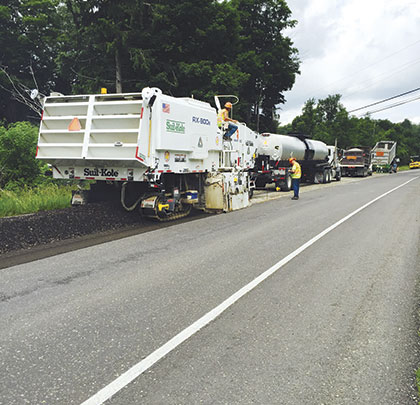If state roads were people, New York State Highway 243 would be considered a good ol’ regular guy, probably named Ned or Roger or Bob. When the old refrigerator needs to be muscled down to the basement, Ned, Roger, or Bob can be counted on to help. That’s what solid, steady guys do—they are there when you need them.
THE PROJECT
New York State Highway 243 has been a stalwart, 11.03-mile east–west state highway in the Southern Tier of New York since the 1930 re-numbering of state highways in New York. Not a rock ‘n roll anthem glory highway, the Ned-Roger-Bob NY 243 has been a utilitarian divided highway that begins at an intersection with NY 98 in the town of Freedom and proceeds southeastward across mostly rural areas of Cattaraugus and Allegany counties to Rushford Lake and then eastward into the town of Caneadea, where it ends at a junction with NY 19.
In 2014, the New York Department of Transportation put out for bid the rehab of 6.6 miles of NY 243. The road surface had aged and was displaying both transverse and longitudinal cracking.
Suit-Kote Corporation, headquartered in Cortland, New York, won the cold-in-place recycle (binder coarse) portion with an $850,000 contract value. Founded in 1921, Suit-Kote is a medium-size, privately owned asphalt products manufacturer, road construction, maintenance, and asphalt applications engineering company, serving the Northeast through its 15 locations in New York and Pennsylvania. Suit-Kote principally focuses on roadwork projects. During peak season, the company has 750 employees and maintains a diverse equipment fleet of 21 asphalt pavers, four stabilizers, and 12 milling machines.
THE SOLUTION
“For the Highway 243 project, we’re using a modified Roadtec RX-900e milling machine to do single unit cold-in-place recycling,” states Zeke Quinlan, vice president of operations for Suit-Kote Corporation. “We’ve gone with CIPR with high float emulsion which helps with coatings and improves wintertime freeze/thaw performance by providing a matt with greater flexibility.”
According to Quinlan, the modified cold planer has a 1.5-foot wider frame that provides better stability, balanced performance, and greater productivity. The completely fabricated, welded, and assembled machine frame is constructed from A656 Grade 80 steel, which is a specialty grade of steel that measures at twice the strength of mild steel that is commonly used.
The modified machine does not have a conveyor, so the aggregate millings, with a chemically-stabilized emulsion-binder, are discharged directly to the roadway in a windrow to be collected by the paver equipped with a “windrow pickup machine.” The paver picks the material up off the ground and sends it through to be paved as the CIPR base layer. The cold planer features a four-track assembly and has a Tier IV Caterpillar engine.
CUSTOM-BUILT FOR THE TASK
With input from Suit-Kote, Roadtec performed much of the cold planer modifications to create the custom single unit cold-in-place recycling machine that they use.
“We made some modifications to fit our needs,” Quinlan says. “Achieving the right weight distribution was a big factor for us, especially with the machine not having a heavy-duty conveyor system.”
An Ingersoll Rand ABG Titan 525 paver from Volvo Construction Equipment followed the cold planer and placed the 4½-inch CIPR base course. Another contractor will complete the roadway with a 2-inch hot-mix asphalt thinlay finish course. The recycled material is left in a windrow directly behind the mill. A paver equipped with a “windrow pickup machine” picks the material up off the ground and sends it through the paver. Now the “CIPR base layer” is paved. An additional new layer of hot-mix asphalt will finish the process.
The NY 243 road surface is a single-lane divided rural highway measuring 22 feet across with 4-foot shoulders on each side. With a milling depth of 4½ inches, a total of 143,000 square yards was milled and all of it was recycled.
SAVING TIME AND MONEY
For this New York State Highway project, Suit-Kote has 12 of its workers dedicated. The contractor will complete the project in 11 days with an additional 10-day cure. The entire roadway upgrade project is expected to be completed in approximately 5 to 6 weeks.
“Our purpose-designed RX-900e saves us time and money on the NY 243,” Quinlan says. “It’s more practical than a complete mill-and-fill, plus we’re recycling 100 percent of the milled old roadway and ensuring non-stop paving.”
The contractor expects that the CIPR will save approximately 50 percent of materials cost, as well as considerable cost savings for trucking—both the trucking of road millings out and HMA brought in—if traditional road rehab methods had been used.
With the Suit-Kote portion of the New York State Highway 243 rehab project approaching the end, Zeke Quinlan reflects: “Our goal is always to end our project knowing we played a role in creating a highway with a smooth ride. It feels good to know that the people who depend on this 6.6-mile stretch will have a good highway for years to come.” ■
About the Author: Jeff Winke is a business and construction writer based in Milwaukee, Wisconsin. He can be reached through www.jeffwinke.com.
_________________________________________________________________________
Modern Contractor Solutions – January 2016
Did you enjoy this article?
Subscribe to the FREE Digital Edition of Modern Contractor Solutions magazine.

Road Rehab


